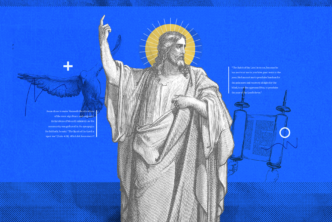The Olivet Discourse is found in Matthew 24–25, Mark 13, and Luke 21. This famously difficult speech by Jesus is, at minimum, a prophecy against the Jerusalem temple. But others also see here a prophecy of Jesus’s second coming as judge of the world. Interpreters differ, because they must examine the bespoke differences between the three Synoptic accounts, explain why each version has its distinctive features, and identify the core claim made in each of the three accounts.
In what follows, I will defend a “preterist” interpretation of Mark 13, viewing it as a prophecy pertaining entirely to the destruction of the Jerusalem temple and the sacking of the city; I will argue that the speech does not look directly beyond those events towards a second coming. On the assumption that Mark is the earliest Gospel—and provided the template that Matthew and Luke followed—I will offer a very brief summary of Jesus and the kingdom, then explain why Matthew and Luke took the shape they did in their particular renditions of the Olivet Discourse. Finally, I will close by briefly investigating whether Jesus ever spoke of his second coming.
Table of contents
Jesus and the future consummation of the kingdom
There is a preliminary move we must make to decipher what Jesus meant by “kingdom of God” and the timing of its present and ultimate manifestation.
Jesus’s teaching about the kingdom of God is disputed in scholarship, because Jesus talked about the kingdom in multiple ways, often with parabolic language. He also rehearsed many Old Testament themes in ways that invited curiosity as much as adversity. However, for want of a working definition, I’d argue that Jesus’s teaching about the kingdom refers to a cross-section of themes related to God’s domain (a realm), dominion (reign), and deliverance (redemption).1
As for the timing of the kingdom, the “when” of its appearance, the kingdom is something that is clearly already present in Jesus’s ministry in embryonic form (Mark 1:15; Luke 11:20/Matt 12:28; Luke 7:28/Matt 11:11; Luke 16:16/Matt 11:12; Mark 4:11–12; Luke 17:20–21). Plus, the kingdom often sounds sometimes like it is even “imminent,” on the cusp of bursting into the world within a short period of time (Mark 9:1; Matt 10:23; Mark 13:30). Jesus’s teaching about the kingdom’s presence, nearness, or imminence comports with Jesus’s apocalyptic energy and the expectation he caused that a dramatic act of deliverance and judgment was soon to take place.
However, unlike other apocalyptic seers, Jesus did not set a time-table for the end and so the kingdom’s final consummation was in some sense indeterminate. Beyond that, the imminence of the kingdom must be understood in conjunction with other passages in which Jesus entertains the possibility of the delay of the kingdom. The trial or testing (peirasmos) has not yet occurred (Luke 11:4/Matt 6:13), persecution implies a further period of activity (Mark 8:35–38/Matt 16:25–27/Luke 9:24–26; Matt 10:16–25; Luke 11:49–50), the parable of the unjust judge contemplates the prospect of postponement (Luke 18:7), Jesus said that he would not drink from the “fruit of the vine” until the kingdom comes in its fullness (Mark 14:25/Matt 26:29/Luke 22:18); and his apparent ignorance of the timing of the end (Mark 13:32/Matt 24:36) may also be indicative of an interval of some kind before the final “end.” Also, the paradox between the imminence of the kingdom and its impending nature is indicative of typical Jewish language for the future, language which could accommodate the arrival of the kingdom as extending over time, in and through a series of events that could invade the present until it unfolded into a definitive future resolution (Jub 23; 1 Enoch 91:12–17).
I would also argue that many sayings of Jesus that appear to imply the imminence of the kingdom, of judgment, or of the coming of the Son of Man can arguably be identified with events other than the end of the ages—including Jesus’s death (Mark 9:1), the destruction of Jerusalem (Matt 10:23; Mark 13:30), or the enthronement of Jesus in heaven (Mark 14:62). Consequently, a given reference to the kingdom’s imminence does not necessarily entail the imminence of the entire eschatological scenario.2
Mark 13: The little apocalypse of Jesus
After digesting that précis on the eschatology of Jesus, we can now tackle the Olivet Discourse.
My claim is that Mark 13 is about the destruction of Jerusalem, vindicating Jesus as the prophet who stood against the temple’s priestly leadership. Its destruction expresses the temple’s unfitness to be the future temple which God had promised a renewed Israel.
The temple was in fact destroyed by the Romans during the Judean rebellion of AD 66–70. If the text is read not as the prediction of the cosmic return of an individual from heaven, but as part of the well-worn Jewish pattern of suffering-vindication, then the Son of Man’s coming can be understood as the vindication of Jesus and his followers. The event forecast is similar to the way that the “one like a Son of Man’s” enthronement in Daniel 7:13–14 correlates with the vindication and victory of the saints of the Most High in Daniel 7:18, 27. The “coming of the Son of Man” in Mark 13:30 signifies that the judgment that transpires in the destruction of the temple constitutes the vindication of Jesus and his followers.3 Therefore, the Olivet Discourse does not directly involve events beyond AD 70.4
To get into the actual details, notice how the whole speech by Jesus is preceded by the disciples admiring the temple—and Jesus then coldly retorting to them that not one stone will be left atop another. To which the disciples understandably ask, “When will these things happen, and what will be the sign when all these things are about to be accomplished? (Matt 24:1–4). If that is the question at hand, then it’s unlikely that Jesus immediately changes the topic and proceeds to refer to his second coming! Rather, what follows, from v. 5 to v. 31 is about the destruction of the very temple that the disciples have been asking about.
In effect, what we find in vv. 5–23 is a summary of civil war, religious sacrilege in the temple, deceivers and demagogues, familial discourse, the persecution of Jesus’s followers, and the devastation of Galilee and Judea upon the Roman pacification of the province. This all fits perfectly within pre-AD 70 Judaea and does not require projection into a future some thousands of years later.
The core text for debate is Matthew 24:24–27:
For false messiahs and false prophets will appear, and will produce great signs and wonders in order to deceive, if possible, even the elect. Behold, I have told you ahead of time! Therefore if they say to you, “Behold, he is in the wilderness,” do not go out, or “Behold, he is in the inner rooms,” do not believe it! For just as the lightning comes from the east and flashes to the west, so the coming of the Son of Man will be. (Matt 24:24–27 LEB)
Robert Stein believes—with many if not most interpreters—that this passage is a parousia prediction, a reference to Jesus’s second coming. He writes:
Mark 13:24–27 is best understood as a theophanic act of God in which the Son of Man comes from heaven and sends his angels to gather the elect from the four winds or corners of the earth … This section concerning the Son of Man will be completed in 13:32–37 by a parable concerning the unknowable nature of the time of the Son of man’s coming.5
I disagree with Stein, because I think Jesus here is using apocalyptic language to describe the terror and turmoil of the Roman siege (then sack) of Jerusalem and the deliverance of the Jerusalem church from those cataclysmic events. Jesus’s words are not about the literal end of the world, but about the end of the world of Second Temple Judaism. The language is no more literal than when Peter quotes Joel 2:28–32 that on the day of Pentecost: “The sun will be changed to darkness and the moon to blood, before the great and glorious day of the Lord comes” (Acts 2:19–20). That did not all literally happen at Pentecost, even with the pouring out of the Holy Spirit; but it shows that a world-convulsing event has happened!
I think my interpretation is proved by two things found immediately after in vv. 28–31.
First, at the end of the speech, Jesus immediately refers back to the cursing of the fig tree (Mark 11:12–14), which was later found withered (Mark 11:20–25) after Jesus’s prophetic action in the temple (Mark 11:15–19). This suggests strongly that the temple is in view again as the object of judgment.
Second, Jesus says that these things will not happen before “this generation” passes away, which means within thirty to sixty years. Now, the temple was destroyed some forty years later, when the Roman general Titus sent his legions into the city, bringing Jesus’s prophecy about the temple to fruition. Despite attempts to stretch the meaning of “this generation” to mean something like “the generation who is alive at the time will see it,” which would be a painful tautology, the most likely meaning is that the present generation would live to see the day when the Jerusalem temple is destroyed.
What about Luke and Matthew?
I think Luke’s version of the Olivet Discourse makes it even clearer that Jerusalem’s sacking is in view, because it refers even more explicitly to siege warfare. Luke says,
They will fall by the edge of the sword, and will be led captive into all the nations, and Jerusalem will be trampled down by the Gentiles until the times of the Gentiles are fulfilled. (Luke 21:24)
Luke thus intensifies Mark’s focalization on the siege and sacking of Jerusalem and the razing of the temple as part of his own account of redemptive history.
But Matthew’s version of the Olivet Discourse is much longer, covering two chapters. It includes extra material such as parables about slaves, talents, sheep, and goats. It certainly sounds more like a final judgment, and Jesus’s return to earth to finally put all things to rights. I suspect that Matthew, for whatever reasons, conflates the tumultuous events of AD 70 with the second coming in a projected future. Or at the very least, Matthew regards the sacking of Jerusalem and destruction of the temple as a preview of the final judgment, when the Son of Man returns to bring justice to the earth. And here’s the problem, since we tend to prefer Matthew’s version of events in the Synoptic Gospels (he’s first in our New Testament, and the most popular version of Jesus’s teachings as far as manuscripts and Google searches go), we all tend to read Mark and Luke as if they are Matthew. That’s why we often think that Mark 13 is about the second coming when in fact it’s really a prophecy about the razing of the Jerusalem temple as God’s judgment against the priestly leadership of Judea.
Did Jesus even speak of his second coming?
One might infer from all this that, apart from Matthew’s interpretive re-application of Jesus’s prophecy of the temple’s destruction to his second coming, nothing Jesus ever said implied that he would one day return as the coming “Lord.” That is not a proposition we need to embrace even if the preceding examination has been convincing.
First, the Olivet Discourse—whether we look at the Marcan, Lucan, or Matthean versions—requires application to a broader scenario that includes the judgment of the nations and the restoration of creation. In fidelity to the narrative of Daniel 7, the judgment rendered against the temple leadership looks beyond the borders of Judea and will eventually extend to the nations. Even the pagan beasts like Rome get their just desst56erts at a future point (e.g. Revelation 18). It makes sense to say that the destruction of Jerusalem itself marks the beginning of God’s final judgment.6 The “Day of the Lord” and the “coming of the Son of Man” that bring judgment on the Jerusalem temple remain a pattern or template for a future judgment of the entire world and the salvation of the elect.
Second, the fact that Jesus spoke both of a future resurrection (Mark 11:18–27/Matt 22:23–33/Luke 20:27–39; Luke 14:14) and a day when the disciples would be appointed as judges over a renewed Israel (Matt 19:28/Luke 22:30) implies that he did see beyond the portentous events of AD 70.
Third, ironically, the clearest mention of a second coming on the lips of Jesus occurs in the Gospel often touted as being the least concerned about Jesus’s second coming. John’s Gospel has more references to “eternal life” than to the “kingdom of God”; it emphasizes the “now” aspect of God’s deliverance rather than a future consummation. Nonetheless, the Johannine Jesus told his disciples in the farewell discourse, “And if I go and prepare a place for you, I will come again and receive you to myself, so that where I am, you may be also” (John 14:3). And the risen Jesus told Peter about John, “If I want him to remain until I come, what is that to you? You follow me!” (John 21:22). The clearest references to a second coming uttered by Jesus are in John’s Gospel.
Fourth, the “word of the Lord” that Paul mentions in 1 Thessalonians is not a prophetic word from the risen Jesus spoken through a prophet, but is probably resourced in the Jesus tradition: sayings of Jesus himself that were transmitted in the church even if not contained in the Gospels. Paul writes:
For this we say to you by the word of the Lord, that we who are alive, who remain until the Lord’s coming, will not possibly precede those who have fallen asleep. (1 Thess 4:15)
This would support the view that Jesus was remembered as predicting a cataclysmic event that Paul believed would affect believers at an unknown yet assured future horizon.
Fifth, the prayerful cry of maranatha deriving from early Aramaic-speaking Christian circles supposes something more than the destruction of Jerusalem and looks forward to Christ’s return as well (1 Cor 16:22; Rev 22:20; Didache 10:6). Added to this, a prerequisite to the final eschatological consummation is that the gospel must be preached to all nations (Mark 13:10; Matt 10:18; 24:14; 28:19–20; Luke 24:46–48; Acts 1:8). And although this can be partly attributed to the period prior to AD 70, ultimately this prediction calls for a more expansive fulfillment beyond that period.
Sixth, according to Luke, the second coming is predicated on the ascension. As the angels told the disciples after Jesus’s ascension,
Men of Galilee, why do you stand there looking into the sky? This Jesus who was taken up from you into heaven like this will come back in the same way you saw him departing into heaven! (Acts 1:11)
Ascension thus implies Jesus’s return.
Conclusion
How would I explain the Olivet Discourse to an audience—whether a congregation, a class, or a friend? The thing I’d emphasize is that the discourse needs to be situated in the context of Jesus’s mission; namely, the preaching of the kingdom (Mark 1:15) and the restoration of Israel (Matt 10:5–6; 15:27; Mark 7:27; Rom 15:8). Jesus announced that Israel was facing a national crisis, that it had to choose how to be Israel. He explained how to be God’s chosen people to some who were choosing the path of violent revolution, to those who were following the pattern and piety of the Pharisees, to those who accepted the status quo of the Herodians, and to those who put put up with the moral and mercantile corruption of the priesthood. He gave them options: follow his way of being Israel, or else find the holy city laid waste and the sanctuary itself desecrated and destroyed. When the evangelists, who probably wrote after AD 70, recorded this event, it was not with a grinning joy of “He told you so,” but one of lament, yet also with a sense of vindication of Jesus and the entire Jesus movement.
What I find helpful is Andrew Perriman’s titanic parable about how Jesus’s followers might have regarded the destruction of the temple and the obliteration of the Judean leadership from the vantage point of believers in Rome seeing Titus parade the vessels of the Jerusalem temple through the streets of Rome to the cheer of crowds or how the news that the temple had fallen would be heard from Jesus followers in Syria or the Decapolis:
Let us imagine first-century Judaism as a ship—a splendid but badly run ship in which the officers and crew mistreat the passengers and squabble and fight over who should have control of the vessel. Blinded by their obsessions and jealousies, no one on the bridge notices that the ship is drifting towards a ferocious eschatological storm. When one or two men raise the alarm, they are seized as trouble-markers, brutally beaten, and thrown overboard. As the winds tear at the rigging and waves wash across the deck, a few brave souls decide to heed the warnings; they lower a lifeboat and take their chances on the rough seas. To the passengers and crew who stay on board this seems a reckless and disloyal move—and at times those clinging desperately to each other in the belly of the small boat, as it pitches and rolls, wonder if they have made the right choice. Some are swept overboard, some die from exposure and hunger. They cry out to the dark heavens, praying that the storm would cease. But they do not give up hope; they believe that they have done the right thing. Then from a distance they watch in horror as the ship strikes rocks and sinks with massive loss of life—they are appalled, but they also feel vindicated. Eventually the wind drops, the waves subside. The lifeboat runs ashore on a sandy beach. They have come to the end of the end; they have survived. This is the beginning of a new age.7
Resources mentioned in this article
The Kingdom of God and the Glory of the Cross (Short Studies in Biblical Theology)
Regular price: $13.99
A New Vision For Israel: The Teachings of Jesus in National Context
Regular price: $15.99
Jesus, the Temple and the Coming Son of Man: A Commentary on Mark 13
Regular price: $16.99
Related articles
- Parousia: What the New Testament Says about the Second Coming
- The Kingdom of God: The Great Unfolding Drama of Salvation
- How Jesus’ Parables Warn Us—If We Can Hear Them
- 1 Thessalonians 4 & the Truth about the “Secret” Rapture

- Patrick Schreiner, The Kingdom of God and the Glory of the Cross (Wheaton, IL: Crossway, 2018), and Graeme Goldsworthy, Gospel and Kingdom: A Christian Guide to the Old Testament (UK: Paternoster Press, 1983).
- Ben Witherington, Jesus the Seer (Peabody, MA: Hendrickson, 1999), 263–65.
- See N. T. Wright, The New Testament and the People of God (London: SPCK, 1992), 280–99; and N. T. Wright, Jesus and the Victory of God (London: SPCK, 1996), 360–67.
- Scot McKnight, A New Vision for Israel: The Teaching of Jesus in National Context (Grand Rapids, MI: Eerdmans, 1999), 130–39.
- Robert H. Stein, Jesus, the Temple and the Coming Son of Man: A Commentary on Mark 13 (Grand Rapids, MI: InterVarsity Press Academic), 119–20.
- Scot McKnight, A New Vision for Israel: The Teaching of Jesus in National Context (Grand Rapids, MI: Eerdmans, 1999), 145.
- Andrew Perriman, The Coming of the Son of Man (Milton Keynes, UK: Paternoster, 2005), 224.





